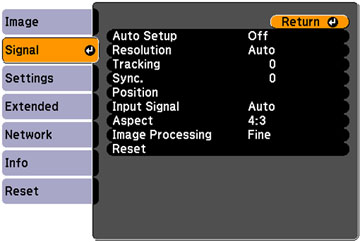Normally the projector detects and optimizes the input signal settings automatically. If you need to customize the settings, you can use the Signal menu. The available settings depend on the currently selected input source.
To change settings for an input source, make sure the source is connected and select that source.
| Setting | Options | Description |
|---|---|---|
| Auto Setup | On
Off |
Automatically optimizes computer image quality (when On) |
| Resolution | Auto
Normal Wide |
Sets the input signal resolution if not detected automatically using the Auto option |
| Tracking | Varying levels available | Adjusts signal to eliminate vertical stripes in computer images |
| Sync. | Varying levels available | Adjusts signal to eliminate fuzziness or flickering in computer images |
| Position | Up, down, left, right | Adjusts the image location on the screen |
| 3D Setup
(PowerLite 4855WU only) |
3D Images | Enables passive 3D images when projecting from 2 projectors |
| Progressive | Off
Video Film/Auto |
Sets whether to convert
interlaced-to-progressive signals for certain video image types
Off: for fast-moving video images Video: for most video images Film/Auto: for movies, computer graphics, and animation |
| Noise Reduction | Off
NR1 NR2 |
Reduces flickering in analog images in two levels (cannot be set if Image Processing is set to Fast) |
| Mosquito NR | On
Off |
Reduces the noise or artifacts seen around the edges of objects that is caused by the decompression of MPEG video (cannot be set if Image Processing is set to Fast) |
| Video Range | Auto
Normal Expanded |
Sets the video range to match the setting of the device connected to the DisplayPort and HDMI ports |
| Input Signal | Auto
RGB Component |
Specifies the signal type from input sources
connected to computer ports
Auto: detects signals automatically RGB: corrects color for computer/RGB video inputs Component: corrects color for component video inputs |
| Video Signal | Auto
Various video standards |
Specifies the signal type from the input
sources connected to the video ports
Auto: detects signals automatically |
| Aspect | See the list of available aspect ratios | Sets the aspect ratio (width-to-height ratio) for the selected input source |
| Overscan | Auto
Off 4% 8% |
Changes the projected image ratio to make the edges visible by a selectable percentage or automatically |
| Image Processing | Fast
Fine |
Adjusts how images are processed
Fast: displays images quicker Fine: displays images in higher quality |
| DisplayPort EQ Setting | 1
2 |
Adjusts the input signal level for the device connected to the DisplayPort connector. Change the setting to reduce interference or correct other image problems. |
